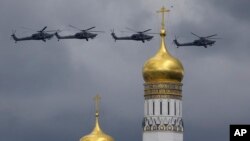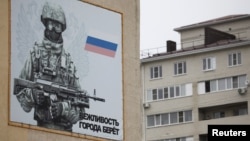Russia recently wrapped up nine days of inspections of its military forces in order to judge their readiness. Russian President Vladimir Putin personally ordered the inspections, which lasted from June 14 to 22.
The surprise inspections involved all four of Russia’s military districts, with the focus on command and control structures as well as military arsenals. Russia's Defense Ministry notified the Organization for Security and Cooperation in Europe (OSCE) about the start of the drills, and Kremlin spokesman Dmitry Peskov stressed that the inspections did not “threaten in any way our neighbors."
Since 2014, tensions between NATO and Russia have risen as a result of Moscow's annexation of Crimea, support for armed separatists in Ukraine’s Donbas region, military intervention on behalf of the Assad regime in Syria, and a generally more assertive military policy toward the West. Against the backdrop of rising tensions between NATO and Russia, some observers see the surprise inspections as a tit-for-tat response to NATO’s BALTOPS, a multinational military exercise in the Baltic region which lasted from June 3-19.
More about Russia than NATO
According to Mark Galeotti, a professor of global affairs at New York University, the inspections were more about Russia than NATO.
“I suspect this reflects an awareness within the Defense Ministry that Russia's reserve system, however impressive it may look on paper, is broken," he said. "The center has little idea of the inventory of equipment it has - how much has been stolen, how much lost, how much doesn't still work - or even the mobilization reserve - who has moved, who is dead, who is sick, who has actually done any of their periodic refresher training," Galeotti said.
Galeotti added, "In that context, such mobilizations are the reserve equivalent of the snap exercises [Defense Minister Sergei] Shoigu instituted: a chance at once to take stock and also begin to get the relevant people such as the voenkomats (military commissariats, which are local military administrative agencies) used again to actually doing their job.”
He also expressed doubt that the timing of the inspections was directly related to NATO’s exercise.
“It could be, in opportunist vein, but if so this only influences timing, not intent," he said. "Primarily, the exercise is about testing and revising the mobilization structure, not just making a political gesture in response to NATO,” Galeotti added.
No coincidence
From a Russian point of view, however, the timing of the readiness inspections isn’t simply a coincidence. Evgeny Buzhinsky, a retired lieutenant general currently with the PIR Center, a Moscow-based think tank, does see a connection between NATO’s recent activities and the readiness drills.
"Well the timing is very natural," he said. "NATO is very active. Russia is trying to be active in response. From a military perspective, it is natural."
Buzhinsky said he was sure the inspections, which he called “combat readiness checks,” were a positive development given the long period of inactivity and decay Russia's military suffered after the fall of the Soviet Union.
“The West got used to the Russian forces not training for 20 years," he said. "Not flying, not training. Absolutely nothing. Now we are going back to the Soviet level of training, of readiness. Sometimes exceeding it...The Russian military command has paid a lot of attention to communications, control, intelligence, which were lagging behind the West. Now we are catching up and that's good. The great part of these exercises is devoted to these aspects of combat readiness," Buzhinsky said.
The Russian military has been undergoing major reforms since 2008. One of the key reforms is the transition from the Soviet model, based on the mobilization of reservists and conscripts, to a standing force consisting mostly of volunteers serving on contract. Modernization and standardization of arms and equipment are also key goals of the reforms.
Jim Kovpak is an American writer in Moscow who runs the Russia Without BS blog.











